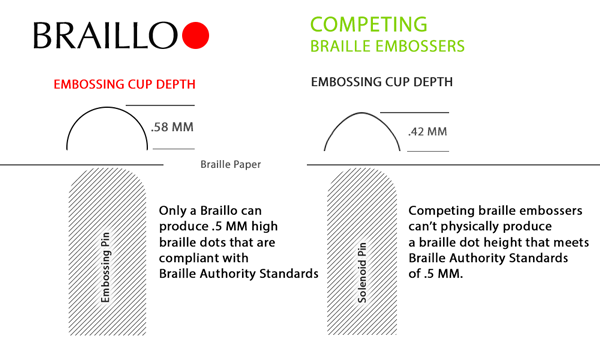Print The Highest Quality & Most Legible Braille
The Importance of Braille Height & Location
One of the most important characteristics of high quality braille is the height of the braille dot itself. Inconsistent heights and low profile braille dots are difficult to read, whereas higher braille dots are naturally easier to read. A legible braille dot through its height is so important that a .46 mm height is the minimum requirement for paper embossing in many countries around the world including the United States. For these reasons, all Braillo braille printers emboss a braille dot at up to a .5mm height.
When creating braille documents for governments and customers around the world, ONLY Braillo can give you the confidence that your documents are compliant. Other manufacturers may falsely claim that they can emboss .5mm braille dots, however, this is simply not true as their machines physically don’t have that capability as demonstrated in the images below.


A Rich Reading Experience Through Braille Dot Height
Have you ever tried to read a printed document where the ink toner was running out so that parts of the text were light and unreadable? This is very similar to what is produced when consumer grade, solenoid-based braille printers are attempting to run at production level speeds and long duty cycles. These consumer grade braille printers, or braille embossers were built for light duty braille printing and can work well under “at home use” conditions, however they should never be confused with a true production braille embosser like those offered by Braillo.
You can quickly identify a consumer grade braille printer, as they look much like a PC printer – small, made of lightweight plastics and have smaller printing components. Some braille printer manufacturers may assemble 2-4 of these consumer level machines together into one “unit” and call it a production embosser, which clearly is not the same as a Braillo true production embosser. When attempting to run a consumer level printer at a high speed or for a long duration, they are quickly pushed past their limits and the braille dots become inconsistent – their already low dot’s height becomes varied, their spacing and placement get wild and the resulting braille text becomes extremely difficult to read. To make matters worse, many braille printers on the market today intentionally create a low braille dot height, which may slightly increase embossing speed, but at the very high cost of poor readability.
When a braille dot is misplaced, or has a low profile, it is similar to a sighted reader attempting to read inconsistent and faded text. The experience is difficult and frustrating, as shown in the example below:

Standards for Braille Dot Heights
| DOT HEIGHT MM | |
|---|---|
| American Library of Congress | 0.5 |
| American National Library for the Blind | 0.5 |
| English Interline | 0.46 |
| English Interpoint | 0.46 |
| German | ≥0.5 |
| Italian | 0.5 |
| Japanese | 0.5 |
| Latvian | 0.45 |
| United Kingdom | .50 |
| Standard American | 0.48 |
| Swedish | 0.25 |


Braillo Braille is Perfectly Aligned
Braillo braille is known as the easiest to read and the reason is simple – our braille is at the proper height and perfectly aligned. When the braille characters aren’t where they’re supposed to be on the page, the reader has to try and guess what the word is supposed to be, or stop and re-read the sentence.
Look closely at this image to the left (click to see a larger view) and you’ll see that our competition’s braille output is wavy and the dots within the rows and columns are not perfectly aligned, whereas the dots from a Braillo are exactly where they need to be.
Would you risk delivering poorly formatted braille with low dot heights that don’t meet a country’s set standards? What about having braille characters that are in the wrong location? Trust in a Braillo to produce braille documents efficiently, with superior formatting and up to a .5 mm dot height, which meets or exceed government requirements. All Braillo’s include Duxbury braille translation software and an industry leading 4 year braille printer warranty.
Braillo Production Braille Printers Are Built for High Volume, High Quality Braille Printing
Braillo braille printers are constructed with precision-engineered, strong metal components and fixed embossing pins. This combination means that there is virtually no lateral movement while embossing, which allows you to print at extremely high speeds 24/7, while still maintaining superior braille alignment and height. With Braillo, you will not get wavy braille and uneven dot heights.
When braille embossing with a Braillo, you create rich reading experiences for your customers, all while meeting the highest formatting standards required by governments around the world.











